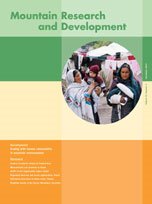Dear Readers,
Mountain people are often considered “vulnerable.” Only if we reflect on and analyze what vulnerability means in concrete terms, and closely examine the potentials mountain communities have in order to face the challenges that make their lives vulnerable, can we find pathways to enhance resilience. Forms of human vulnerability in mountains vary: dynamic biogeophysical environments increase the likeliness of exposure to natural hazards; scarce resources and harsh conditions make people vulnerable to food insecurity and health risks; this can be increased by economic and political marginalization; moreover, many mountain regions are beset by conflicts that affect local populations. Although mountain communities have a long tradition of coping with their inherent vulnerability, today this ability is jeopardized by changes at the global level, centralized decision-making, and increasing pressure on natural resources. This calls for approaches that strengthen the inherent adaptive capacity of people, environments, and economic and political conditions, and links them to science-based proposals for solutions.
The article by Hamilton and Halvorson on women's experiences in the 2005 Kashmir earthquake makes a strong plea for building on women's seismic knowledge and their active roles in relief and reconstruction. In order to do this, it is necessary to listen to women and begin with a comprehensive vulnerability and needs assessment. The holistic Nepalese development project presented by McKay, Zahnd, Sanders, and Nepali, which aims to reduce very marginalized communities' exposure to health risks through technical innovations, insists on the need for an iterative process that combines research and participatory development activities. The article by Ehsanul-Haq focuses on the potential of community institutions to effectively tackle the consequences of severe climatic hazards in Pakistan, while Gaillard and Le Masson underline the resilience of previously very isolated indigenous communities in the face of the combined stress of volcanic hazards and centrally imposed resettlement in the Philippines. Finally, focusing on Guatemala, Steinberg and Taylor show how unequal access to resources in a context where decades of civil war have made the environment and population particularly vulnerable can lead to problematical development choices such as illicit crop production. Here, human vulnerability can only be reduced by a long-term development perspective and the building of trust.
The first 3 articles in the Research section also deal explicitly with different aspects of exposure to risks in mountains and suggest possible approaches: Halvorson and Hamilton discuss the social impacts of recent major earthquakes in Central Asia and the need to revive “seismic culture.” Andersen offers a much needed review of soil micronutrient problems—which affect both crop productivity and health in Nepal—and outlines a research agenda for the future. Bajracharya, Shrestha, and Rajbhandari present a GIS-based hydrodynamic modeling of glacial lake outburst floods to assess potential GLOF risks in the Sagarmatha region. The other 3 papers focus on vulnerable forms of native mountain vegetation in protected areas: Måren and Vetaas assess the ecological impacts of (regulated) forest use on a keystone forest species in the Annapurna region, while Wang Tie, Li Mei, and Wang Naian present a geographic information system for zoning nature reserves (NRGIS) which they apply to a Biosphere Reserve in an eastern Chinese mountain range harboring an endemic species of cedar. Finally, Pickering and Hill review research on exotic species in Australian Alpine grasslands and assess the “weed” qualities of 8 of these species.
We hope readers of this issue will gain new insights into the nature of various forms of vulnerability and resilience in mountains and reflect on ways research can propose science-based solutions that promote the adaptive capacities of mountain





